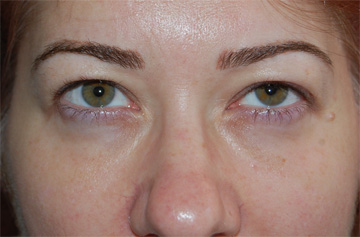Brow lift
Many patients are surprised that a browlift is recommended at the time of the upper blepharoplasty in order to adequately correct the excess skin on the upper eyelids. When the brows are droopy (Brow ptosis) the eyelid skin is pushed down, adding to the excess skin on the upper eyelid. Simply removing extra skin from the eyelids does not improve the result and can lead to an even lower position of the brows and difficulty closing the eyes. In extreme cases, excessive eyelid skin removal can lead to brow hair blocking the visual axis. This can be prevented by judiciously removing skin from the upper eyelids and performing a brow lift whenever necessary for achieving the optimal functional and cosmetic result.
There are 5 modern techniques currently used to lift the brows and the forehead: Internal Brow Suspension, Internal Brow Sculpting, Corrugator Removal, Endoscopic Forehead Lift and Temporal Lift.
Browpexy, Internal Brow Sculpting and Corrugator Removal can be done through the same incision as the upper blepharoplasty. The endoscopic brow lift is a forehead lift performed through 4 small incision behind the hairline. A temporal lift is performed through an elliptical incision strategically placed in the hairline above the lateral part of the brow.
Each technique is carefully selected on an individual basis depending on patient’s anatomy and desired result.
Surgery and Recovery
Most Brow Lift procedures are performed under local anesthesia or mild sedation depending on the patient’s preference. Surgery lasts between 30 and 90 minutes and the patient goes home the same day. Endoscopic Forehead Lift is the only procedure that requires general anesthesia.
Most patients take between a weak and ten days off after a Brow lift. Compressive bandages are used only with the Endoscopic Brow Lift and are removed the following day. Stitches dissolve 10 days after surgery. Bruising and swelling can be expected for a couple of weeks. Cold compresses are applied to reduce swelling and bruising in the first 48 hours. Antibiotic ointment or drops may be prescribed. Strenuous activity should be minimized for several weeks. Warm compresses may be recommended after several days to increase blood flow to the area and promote healing.
-
Practical information:
Length of surgery: 30-90 min
Anesthesia: local or general sedation
Hospitalization: ambulatory (day surgery)
Downtime: 1-2 weeks

